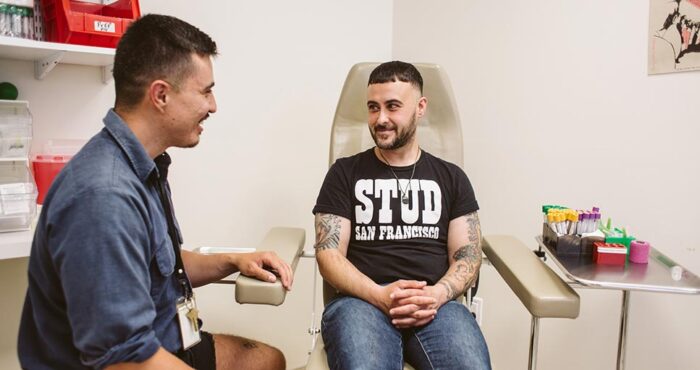The View from Here: Dr. Anthony Fauci & Dr. Steven Deeks
2011 marks the 30th year of AIDS. “The View from Here” is a special year-long series to mark the anniversary. Advocates, doctors, researchers, politicians, philanthropists, educators, public health professionals, journalists and celebrities are answering the same set of questions each month.
This month, we feature two of the nation’s leading scientists overseeing research that is improving the lives of all people living with HIV/AIDS: Dr. Anthony Fauci, director of the National Institute of Allergy and Infectious Diseases, and Dr. Steven Deeks, professor of medicine in residence at the University of California, San Francisco and a faculty member in the Positive Health Program at San Francisco General Hospital.
We’ve learned a lot in 30 years. What do we have yet to learn?
Dr. Fauci: In the past 30 years, we have witnessed extraordinary scientific progress in the fight against HIV/AIDS. Notable research advances include the groundbreaking discovery of HIV as the cause of AIDS; the creation of an HIV diagnostic; an understanding of how the virus is transmitted to and infects humans; the elucidation of the immune response to HIV and the events leading to the development of AIDS; the development of more than 30 licensed lifesaving antiretroviral medications (ARVs); and a rapidly growing toolbox of proven methods for preventing HIV infection. Today’s prevention tools include, among others, ARV regimens to prevent mother-to-child transmission, medically supervised adult male circumcision, topical microbicides, pre-exposure prophylaxis with ARVs, and treatment with ARVs as prevention.
However, there are still significant research challenges to overcome. The real game-changer would be developing a safe and effective vaccine that protects against acquisition of HIV infection and adding that to our combination of prevention tools. A major obstacle to developing a preventive HIV vaccine is that the body does not mount a natural immune response that can neutralize the virus. Therefore, we must develop a vaccine that does better than natural infection—no easy task. In 2009, we reported a conceptual breakthrough on this front when a candidate vaccine being tested in Thailand showed modest protection against HIV infection in vaccinated volunteers. Researchers now are working to understand and build on those findings. Scientists also are analyzing in exquisite detail key molecules of the virus as the basis for developing structure-based candidate HIV vaccines. Another major scientific challenge that remains is finding a cure for those already infected with HIV. This could be done either by eradicating the virus or, more likely, through a functional cure—that is, enhancing the immune system to the point where an individual permanently suppresses the virus to very low levels in the absence of antiretroviral therapy. Alternatively, gene therapy approaches are being studied to modify the immune system cells such that they are refractory to being infected with HIV.
Dr. Deeks: In terms of the management of infected individuals, which is the focus of our research, there are two major unknowns. The first is “why does HIV persist indefinitely during long-term, apparently effective therapy?” We will need to answer this question before we can begin to develop novel interventions aimed at curing the disease, which is likely to become a major effort among researchers in the next decade. The second question is “why does inflammation and/or immune dysfunction persist despite, again, apparent effective therapy?” This is important because most of the complications that patients are currently experiencing likely relates at least in part to this chronic inflammatory process. There are a lot of other questions outside of the therapeutic area which are of interest to the field in general, including the determinants of HIV transmission and potential approaches to vaccines, but I will let others comment on these issues.
What was your deciding moment, when HIV/AIDS became an important issue in your life?
Dr. Deeks: I trained at San Francisco General Hospital between 1990 and 1993. In hindsight, these were likely the worse years in the epidemic, at least locally. Over half of the hospital beds had young, previously healthy people basically dying of an incurable disease. As you can imagine, it was a depressing time for everyone involved, and not necessarily something that inspired me to pursue my current career. Although my inpatient work was challenging, my outpatient experiences were completely different. I recall in particular caring for Joe, who was an asymptomatic young man full of life and entirely engaged in his care. Like many of his generation, he was well-informed, active in HIV care on many levels, and a great partner in terms of providing care. At that time, the physician-patient relationship was more formal that it is these days, and I think HIV in general has led to a new way in which patients and their clinicians interact. When Paul Volberding offered me the chance to work in the outpatient clinic for one to two years, I immediately took the job. My plan had been to work for a few years and then go back and get more training in some type of fellowship. Once I was working in the clinic, I began to make observations, generate some testable questions and formed collaboration with like-minded scientific colleagues. Almost immediately, I was providing care to a highly engaged population and working with my patients to ask and answer questions of scientific interest. Once this happened, I never wanted to leave, and have had essentially the same position for much of the past 18 years.
Dr. Fauci: The June 5, 1981 Morbidity and Mortality Weekly Report (MMWR) describing cases of Pneumocystis pneumonia among five previously healthy young, gay men in Los Angeles piqued my curiosity, but it was the second MMWR one month later–which reported 26 cases of a rare cancer known as Kaposi’s sarcoma as well as Pneumocystis among gay men in New York City and California—that literally transformed the direction of my career as a physician-scientist. The cause of the underlying illness was at that time unknown, but it was clear that it was acting like a sexually transmitted infection and likely one caused by a virus. I knew that this illness was not going to stay confined to gay men.
In the summer of 1981, I completely changed the direction of my career from studying inflammatory diseases and the interface between immunology and infections in general to studying patients with this mysterious disease. For the first few dark years of the epidemic, the best we could do for our patients was to treat their symptoms, provide palliative care and observe them to try to learn as much as we could. Only after the virus was discovered in 1983 and then established as the cause of AIDS in 1984 could my laboratory intensively study the pathogenic mechanisms of HIV infection, which I continue to do to this day.
With ever-increasing public health issues to contend with, why should anyone still prioritize HIV/AIDS?
Dr. Fauci: HIV/AIDS is among the most catastrophic public health challenges that mankind has ever faced, ranking up there with the bubonic plague that swept through Europe in the 14th century, the 1918 influenza pandemic that killed an estimated 50 million people, and the measles and smallpox pandemics that have afflicted the world throughout the centuries. Approximately 30 million people with AIDS have died since the beginning of the pandemic, including nearly 600,000 people in the United States. Currently, there are 33 million people worldwide living with HIV, including 1.2 million people in the United States. Each year, approximately 2.6 million new HIV infections and 1.8 million HIV-related deaths occur worldwide. Important programs such as The U.S. President’s Emergency Plan for AIDS Relief (PEPFAR), the Global Fund to Fight AIDS, Tuberculosis and Malaria, as well as the efforts of health and philanthropic organizations have been responsible for providing anti-HIV drugs to more than 6 million infected people in the developing world, transforming the global landscape of AIDS. Still, we do not have the pandemic under control, and in certain regions of the world, particularly in resource-constrained countries, the human toll of HIV/AIDS continues to devastate societies.
In addition to the terrible burden of disease and death that HIV/AIDS exacts, it also is an enormous financial burden. For example, the annual cost of HIV care for a person in the United States is approximately $20,000 per year. Over the course of a single individual’s lifetime, this can add up to hundreds of thousands of dollars in costs to our healthcare system.
Dr. Deeks: HIV remains an actively expanding epidemic that is traumatizing many communities, both in the United States and internationally. We therefore need to maintain our focus and keep the management and study of HIV a national priority. I suspect most would agree with this sentiment.
There are other less obvious benefits of maintaining our commitment to the study of HIV disease. For example, I was recently involved in a discussion in which a novel observation was made that might explain why HIV seems to persist indefinitely despite the use of effective therapy. Without going into the details, it became very clear these observations might have huge implications for how all drugs work (and, more importantly, how they sometimes fail to work). This actually happens all the time in HIV research. Another classic example is the treatment of Hepatitis B. Some of the anti-viral drugs that were developed for HIV actually have potent activity against Hepatitis B, and it’s now a manageable disease in large part because of what happened in HIV. The same thing is probably going to happen in the management of Hepatitis C and other chronic viral infections. This type of cross-discipline interaction—which happens all of the time—is largely due to the fact that we know so much about this disease. As a consequence of the huge investment that has been made into HIV, we are learning on a daily basis things we just can’t learn in other fields simply because the investment wasn’t made. Hence, many of the advances made in the world of HIV clearly have a huge impact on what’s happening elsewhere.
What keeps you up at night?
Dr. Fauci: What keeps me up at night is the possibility that the life-saving fruits of HIV research will not reach the people who need them most. For the first time in the history of the pandemic, we have the scientifically proven tools in the form of effective treatment and prevention to make extraordinary inroads in controlling the AIDS pandemic worldwide. We must accelerate the transition from scientific advances to implementation of life-saving programs. At the same time, we are now living in an era of severe financial constraints. Unless we recognize the unprecedented opportunity we have today, and invest resources appropriately, in the long run, fighting the HIV/AIDS pandemic will cost even more both in terms of financial resources and lives lost.
Dr. Deeks: My major concern, in terms of what’s happening now, is as a consequence of the global recession we’re taking a step backward in terms of getting therapy to those who most need these drugs. This is clearly happening in resource-constrained areas like Africa, but it’s also happening in places like San Francisco. As a consequence of the economic changes occurring in our city, a large number of individuals, primarily those who are working but cannot afford insurance, are unable to find good clinicians and sometimes are unable to find a way to pay for antiretroviral therapy. I’ve had a few patients who lost their health insurance and had to essentially fall into poverty before the public health care system could begin to provide them with care. One patient had to stop drugs for over a year and ended up very sick, unemployed and homeless. It was ony at that time that I could get him back on therapy. This is shocking, because I have always believed that San Francisco is the best place in the world to access HIV care. And if it’s happening now in San Francisco, it’s going to happen elsewhere in the future. Hence, my biggest concern is that changes in the global economy is will lead to many people, including those in our country, will not be able to routinely access the care they need.
Three decades into the epidemic, what gives you hope?
Dr. Deeks: Despite the challenges I’m facing in terms of providing care for my patients, I’m still inspired by the capacity of my colleagues to advance the field in terms of basic translational clinic research. Resources are still available to really untangle what’s happening in terms of this chronic inflammation and addressing the issues of HIV cure. I’m hopeful those resources will persist. I’m also inspired by the increasing attention being paid to collaborative source research, both locally and internationally. I think this culture shift ways from “fiefdoms,” or individual labs, to more collaborative research will really result in significant advances both for HIV and other disciplines. I suspect we are entering a decade of truly revolutionary advances in our understanding of HIV pathogenesis and HIV treatment. I am also hopeful our work will continue to have benefits for other areas of medical research and clinical care.
Dr. Fauci: In the past 30 years, we have completely transformed the lives of HIV-infected individuals through the development of treatments that have turned an HIV diagnosis, once an almost-certain death sentence, into what is now for many a chronic, manageable disease. In addition to our robust menu of life-saving anti-HIV treatments, an increasing number of scientifically proven modalities have recently been added to our HIV prevention toolkit.
The reason I have hope is that we already have within our grasp the scientific wherewithal to turn around the trajectory of the HIV/AIDS pandemic using these treatment and prevention tools. It is now up to all of us to demonstrate the political and social will and dedicate adequate resources to effectively translate these scientific advances into practice, and in doing so, save millions of lives and reduce the future financial burden to societies around the world.









